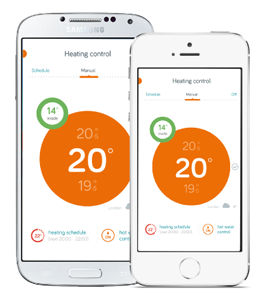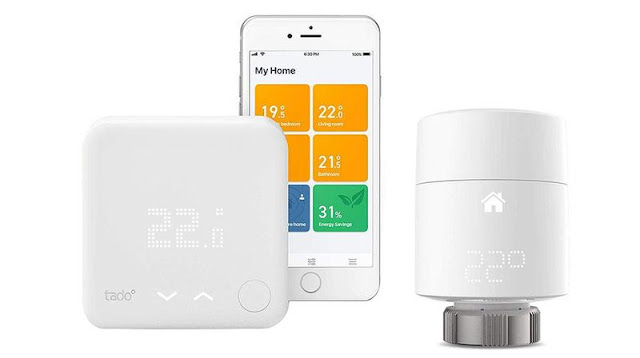 |
| Hive vs Nest: which is the best smart thermostat? |
There are lots of smart thermostats to choose between now, with Nest and Hive two of the best known and most popular. Here we look at the differences to help you decide if one of them is right for you. It's Hive vs Nest.
There are lots of smart thermostats to choose between now, with Nest and Hive two of the best known and most popular. Here we look at the differences to help you decide if one of them is right for you.
We've tested many of the new systems in our best smart heating systems roundup.
Smart thermostats are the biggest development in heating technology in three decades. Instead of a primitive timer or indecipherable programmer unit, the new smart thermostats simplify everything as well as allowing you to control your heating using your smartphone – wherever you are.
Pricing
Hive Active Heating 2 costs £249, and that includes installation. There’s also an option to install it yourself, which knocks the price down to £179. These are slighly higher than the prices for the original Hive system. Contrary to popular belief, you don’t need to be with British Gas to have Hive. It works with any supplier and with most boilers. You can, of course, look out for deals where you get the system free if you switch to British Gas and if you're already a first-gen Hive owner, you can upgrade to the new thermostat for £99.
You can buy a Nest and install it yourself for £179 (£199 for the 3rd generation). Google strongly recommends professional installation, however, which bumps up the price to £249 as well.
How Do They Work?
Both thermostats work in a similar way, and you can choose where they’re installed in your home. Each kit comes with a box that plugs into your broadband router, and another box that connects to your boiler to give it the 'on' and 'off' commands.
Both can also control your hot water cylinder if you have one, replacing any existing timer control you may have. Note that the 2nd-generation Nest doesn't do this, but the brand new 3rd-gen does. In effect, the gadgets are a direct replacement for your existing thermostat and use a single point in your home to measure temperature: all radiators are heated until the desired temperature is met, then the boiler is turned off.
It's more complicated in reality as due to algorithms that learn how quickly your home heats and loses heat, but if you don't want certain rooms heated - or don't want them as hot, you have to adjust your radiator valves manually or invest in multiple thermostats to control separate zones. If your plumbing is set up so that all the radiators are heated at the same time, you only have one zone and buying multiple thermostats is a pointless exercise. What you can do is to invest in smart TRVs, such as the Eve Thermo or Devolo Home Control. These give you control over individual rads from your phone, but not the boiler. Plus, you have to use a separate app.
The interfaces for Hive and Nest are different, although while the original Hive controller looked more like a traditional programmer, the new one (as with Nest) is a rather more modern-looking and desirable object.
The same is true of the Hive: it doesn’t have to be installed where your old thermostat was – typically on the wall in the hallway. The second-gen Hive thermostat is powered by AA batteries and has a colour screen hidden behind its mirror-finish exterior.
Both systems operate on a schedule you set, but Nest can learn your routine and create a schedule automatically - if you let it. Both also have geolocation and can alert you that you've left the heating on after leaving the house, or automatically turn it off for you. To use these sytems, everyone needs to have a compatible smartphone and opt into the geolocation feature.
Will It Work With My Boiler?
The answer is “most probably, yes” unless you have a very old or unusual type. Both systems, though are compatible with a wide variety of boilers, not just the modern condensing type.
It’s worth checking on Hive’s website and Nest’s site to see if your heating system is compatible.
Bear in mind that both systems can control only one zone as standard, with additional thermostats required if you want to control multiple zones and have them at different temperatures. As we've said, you will need a heating system which actually has multiple zones (typically multiple valves) to make use of multiple thermostats. Hive 2 is now available as a multizone system, and it supports wet underfloor heating, just as Nest does.
The Apps And Remote Control
There’s a Hive app for iOS and Android, and you can use it to turn the heating on or off, as well as edit the heating schedule.
The latest update enables you to opt in and use your phone's location to better work out whether anyone is home or not.
Other Features
Both systems go beyond heating, with Nest offering a combined carbon monoxide and smoke detector, the Nest Protect. It has also added a camera to its repertoire, the Nest Cam, reviewed.
Hive is going in a similar direction and wants the Hive app to be your hub for controlling all your smart home gadgets. It plans to launch a range of connected products including motion sensors, smart plugs (for turning appliances on and off remotely) and integration with third-party security cameras.
How Much Will You Save?
British Gas claims you’ll save up to £150 per year on your energy bills, while Nest says the figure is roughly 20 percent. Given that this doesn’t affect your electricity consumption – at least not by much – it’s about the same figure, give or take.
Don’t assume that these systems will pay for themselves inside 18 months. They probably won’t. Merely turning down your heating by 1 degree is said to save around £75 per year.
However, Hive and Nest aren’t just about saving energy and money. They’re also about convenience and comfort. As well as being able to turn off the heating remotely, you can also switch it on. And that’s great for those times when you arrive home unexpectedly early. The house can be warm, or warming up before you arrive.
As for which is best, it's a close call. With their previous iterations, we've have said Nest, but the latest versions are a match for each other, both in features and price.












.jpg)






0 comments:
Post a Comment